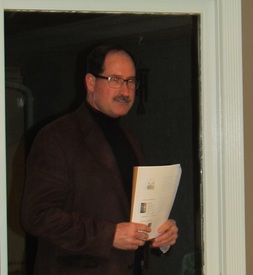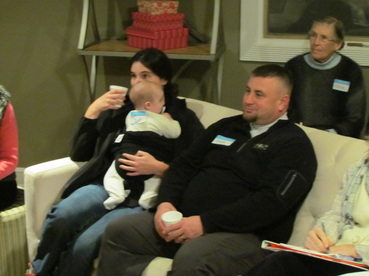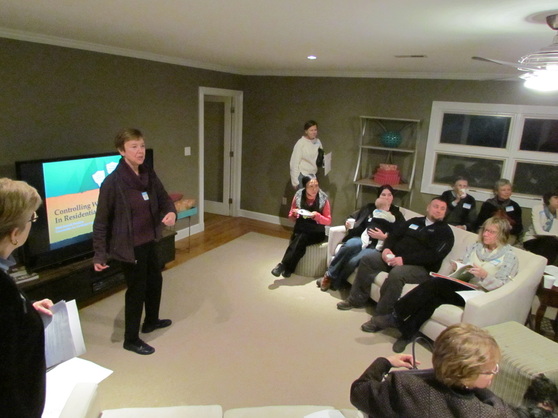|
At the home of Julie Friedman in Rockville Submitted by Susanna Membrino, posted by Anne Underwood The first LDG meeting of 2015 took place in Rockville at the home of Julie Friedman. After some snacks including some wonderful homemade stuffed grape leaves, the group of twenty or so members heard two presentations on weed and pest control.  Mark Emmell, president of Greensmiths, Inc. spoke on controlling weeds in residential gardens. Defining a weed as “a plant that occupies space in the garden where it is not welcome,” Mark noted that weeds grow faster and more easily than chosen plants, that they are mostly distributed by wind and birds and that they can steal water, sunlight and nutrients from more desirable plants. Mark’s weed mantra is “Don’t let weeds flower and seed.” Weeds spread several ways, including by rhizomes, tubers, bulbs, stolons, creeping roots and seeds. Efforts to control them take many forms, some helpful some not. A light mulching, for example, controls some weed growth but hyper-mulching is detrimental to cultivated plants. Weed control fabrics are not very effective under mulch, but very effective under stone. Plastic sheeting is ineffective on slopes but can “solar cook” weeds. For chemical controls timing vis a vis weather and plant stages is critical. Pre-emergent granular and post-emergent liquid herbicides are very cost-effective but should not be used near water. Vinegar applied during hot weather is very effective as are boiling water and propane torches. Corn gluten is not terribly effective. Glyphosate, the active ingredient in Round Up, will kill plant roots but do not let it touch your skin. Spray poison ivy in the fall when it is sending sugar to the roots. Compost weeds separately from leaves and grass. Mark named 5 most common weeds and their mitigation methods: 1. Yellow and Purple Nutsedge—Sedgehammer and Solitaire; Wild Bermuda grass—digging to 4” minimum or spraying 2-3 times in July; 2. Japanese stilt grass—hand weed and apply pre-emergent (Snapshot) under mulch; 3. Bamboo—dig out and install concrete or metal barriers 2’ deep and 6” above ground or cut just below node and fill cups with glysophate; 4. Poison ivy—dig out or spray in fall. 5. For turf Mark recommends mowing to 3.5 to 4”, maintaining soil pH at 6.5 to 7, fertilizing and overseeding at the proper time. UDC will now do soil testing. Mark’s Number 1 weeding tip? “When weeding, the best way to assure you are removing a weed vs. a valuable plant is to pull on it. If it comes out of the ground easily, it’s a valuable plant.”  Steve Castrogiovanni of Mead Tree and Turf then spoke on Integrated Pest Management (IPM). IPM depends critically on monitoring garden plants to be sure they do not surpass agreed-upon thresholds of pest infestations. Damage begins to show at 5 to 8% infestation. A question was raised about boxwood damage. Steve says that one of the common problems with boxwoods is the use of irrigation sprays that hit the plant directly creating soil moisture problems causing macrophoma blight or volutella which leads to orange or yellow leaves. Another problem is the Mosquito Squad, which kills all insects, harmful or not, which soon leads to an explosion in the aphid population. Other ways for treating mosquitoes are avoiding over-irrigation, clearing gutters and drains of standing water, and treating birdbaths and drains with mosquito dunks. The rule of thumb is to go with the least toxic chemicals first. Releasing beneficial organisms such as ladybugs is not practical since there is no way to keep them within the garden. A cultural issue is always to plant a plant in the right place. It also helps to prune out the dead sections of plants. Start with low toxicity, use narrow spectrum treatments for the problem at hand, and use narrow spectrum sprays. You may not get control with the first application. Rotate chemicals to avoid resistance. Use more toxic options only as a last resort. Mike then listed some of the treatments he uses. Horticultural oil is good and he recommends Pure Spray. Still, it loses its potency when the temperature goes above 85 degrees F. Horticultural soaps are also very useful. The firm uses horticultural soaps on crapemyrtle plants for aphids. They also use BT, a bacterium; PHC which contains microrhyzomes; Biopak Plus, and Acelepryn which is very expensive and good on Japanese beetles. Mead uses compost tea extensively as part of its program. Mike emphasized that IPM requires that you communicate with clients and educate them. One of the drawbacks of using IPM is that the work is front-loaded, that is, the first part of the process of returning plants to health is very costly, requiring a large initial investment of time and effort. Once the pests are under control, periodic monitoring is key but requires less expenditure of resources. Staff training is also key. The presentations elicited many good questions and discussion. A BIG THANK YOU to our speakers, Mark and Mike, and to Julie Friedman for hosting us. Mary Rollefson closed the meeting with some announcements:
The next LDG meeting will be in DC on February 26 on the design of rain gardens and selection of rain garden plants. Details about the meeting will be forthcoming on the LDG listserv. LDG is looking for a co-secretary to help Dawn starting in May or June. On Saturday, February 7, GW is holding a symposium on promoting your business on social media and could use a volunteer to represent LDG and recruit new members. A representative from Houzz will be there.
0 Comments
Leave a Reply. |
AuthorsLDG is a non-profit corporation dedicated to the exchange and enhancement of knowledge relevant to the landscape design profession. We are a group of professional designers in the metropolitan Washington, DC area. Membership is meant for students studying and professionals employed in landscape design or associated professions (i.e. arborists, installers, contractors, etc.). Archives
October 2023
CategoriesPast Newsletters can be found in the Members Only Section of the LDG Membership Connection. You must sign in to view these files.
Past Newsletters |
|
Search for a Landscape Designer in Your Area:
|

 RSS Feed
RSS Feed
